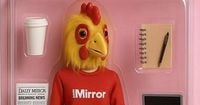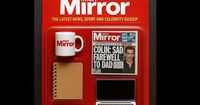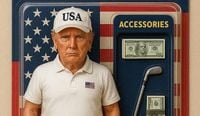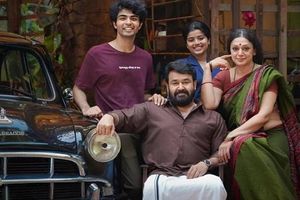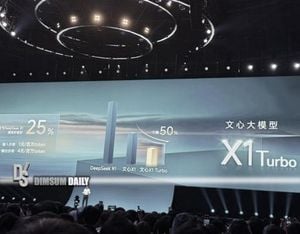Another week, another AI trend sweeping the internet! ChatGPT is once again dominating our feeds, this time with a new trend blowing up across Instagram called ‘the AI Barbie Box Challenge.’ While Barbie summer may have been over two years ago now, this trend is ideal for those who’ve ever imagined themselves as a doll.
The viral trend sees people turning themselves into packaged action figures styled like Barbie dolls, alongside a series of accessories that best describe who they are. From brands to celebs to your next-door neighbor, everyone who’s anyone is inventing a little mini-me animated doll, and you can too, if you follow these easy steps.
To create your own AI action figure, follow these instructions:
- Open the ChatGPT app on your phone or in your web browser.
- Upload your desired photo(s) of yourself.
- Use this prompt: ‘Using this photo, create an action figure style image in a box. Inside the box, include [list of accessories]. The box should say {your name} in large writing, and underneath it should say [your description]. The box should use [brand colours].’
- Make adjustments as desired.
However, proceed with caution, as one AI trend got none other than Tanaiste Simon Harris in trouble last month. Earlier this month, the Fine Gael leader participated in a social media trend that saw people use artificial intelligence to transform their photos into Studio Ghibli-style snaps. However, the program used by the Tanaiste left him in a sticky situation, with a certain Irish term being wrongly translated in the process.
The latest viral toy trend uses AI to create your own action figure lookalike. As AI continues to transform how we go about our daily lives, there are some fun trends connected to the revolution, which are blowing up social media. The 'AI Barbie Box Challenge' has taken over TikTok and Instagram, allowing users to see themselves as toy dolls.
Once ChatGPT creates your personalized action figure styled like a Barbie doll, it is placed into a little plastic box—just like you would see in shops. Some celebrities have joined in on the trend, including popular pastor Michael Todd, who showcased his AI-generated doll to his two million Instagram followers, demonstrating just how accurate the AI-generated dolls can look.
There have also been doll versions of political figures like Keir Starmer, Liz Truss, and Donald Trump seen all over social media, adding a humorous twist to the trend. Many users are loving this fun and unusual trend. One user wrote: "Can we talk about how CUTE these action figures are?! I mean… is this not giving main character energy? Apparently, ChatGPT is here to feed my delusion. I didn’t know I needed a mini version of myself until now!" Another person added: "Ahhh right!! Never one to become a laggard in this new AI era — loving these ChatGPT image prompts."
While the trend is entertaining, it also builds on the lasting appeal of the 'Barbiecore' aesthetic, with a new twist that leans into the nostalgia of 1990s and 2000s toy commercials. The images often feature bold colors, dramatic lighting, and customized accessories, complete with logos, taglines, and fictional character stats. The result? A visually striking, shareable piece of digital art that brings a toylike fantasy to life.
For those looking to jump on the trend, creating an AI-generated action figure portrait involves a few key steps:
- Write a ChatGPT prompt. Users can start by crafting a detailed prompt in ChatGPT’s image generation feature. A sample prompt might be: "Generate an image of a person styled as a futuristic action figure in a plastic toy box, with bold colors, accessories, and dramatic lighting. Include the phrases 'Collectible Edition' and 'Hero Mode Activated' on the packaging."
- Upload a reference photo. To enhance accuracy, users can upload a high-resolution selfie or reference image. They can specify elements to retain, such as hairstyle, outfit, or pose, ensuring the AI-generated figure resembles them.
- Refine the design. If the first result isn’t perfect, users can tweak their prompts, adjusting background colors, adding accessories, or refining the box design.
- Add text and effects. For a more realistic toy-box effect, users can request AI to generate images with embedded text, such as toy labels, logos, or character power stats.
- Download and share. Once satisfied with the final design, users can download the image and post it across social media platforms, often using hashtags like #BarbieBoxChallenge to join the viral trend.
While no single creator is credited with starting the trend, it gained momentum in early 2025, fueled by TikTok users sharing their AI-generated boxed avatars. The aesthetic has resonated with those who grew up with action figures, bringing a sense of nostalgia while showcasing AI’s creative potential.
This isn’t the only viral AI trend coming out of ChatGPT. Just last month, Irish users were hooked on turning their photos into Studio Ghibli-style animations, mimicking the look of beloved films like Spirited Away and My Neighbour Totoro. That particular trend sparked debate in artistic circles—especially after a viral clip resurfaced of Ghibli co-founder Hayao Miyazaki condemning AI-generated art. In a clip from 2016, the legendary animator was seen to react to a presentation on AI in animation, stating: "I am utterly disgusted. I would never wish to incorporate this technology into my work at all." Looking at an AI-generated image of a zombie-like creature crawling on the ground, he remarked: "I strongly feel that this is an insult to life itself." His powerful disagreement with artificial creativity starkly contrasts with the current excitement surrounding AI art.
As the AI Barbie Box Challenge continues to capture the imaginations of users worldwide, it raises questions about the future of creativity in the digital age. Will this trend pave the way for more innovative uses of AI, or will it lead to further debates about the nature of art and originality?
